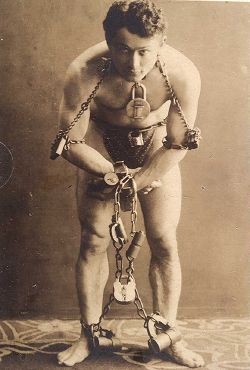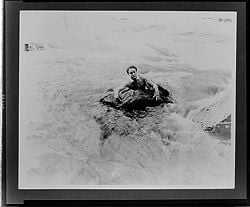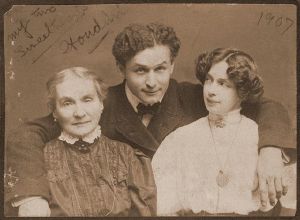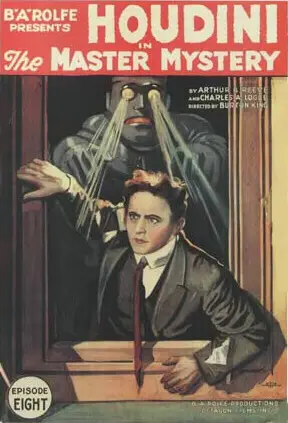Harry Houdini
| Harry Houdini | |
 Harry Houdini became world-renowned for his stunts and feats of escapology even more so than his magical illusions.
| |
| Born | March 24, 1874 Budapest, Hungary |
|---|---|
| Died | October 31, 1926 Detroit, Michigan, USA |
| Occupation | magician, escapologist, stunt performer, actor, historian, pilot, rumoured spy, and paranormal investigator. |
Harry Houdini (March 24, 1874 – October 31, 1926), born Ehrich Weiss, was a Hungarian/American magician, escapologist, stunt performer, as well as an investigator of spiritualists.
Birth and immigration
Houdini was born as Erik Weisz in Budapest, Hungary to a Jewish family; upon immigration to America the family name was changed to Weiss because of immigration purposes and his first-name spelling to Erich. His father, Mayer (Mayo) Samuel Weisz (1829-1892) also known as Samuel Mayer Weisz (1829-1892) was a rabbi; and his mother was Cecilia Steiner (1841-1913). Ehrich had the following siblings: Armin M. Weiss (1863-?); Nathan J. Weiss (1869-?); Gottfried W. Weiss (1872-?); Theodore Weiss (Dash) (1876-1945); and Leopold D. Weiss (1879-?). From 1900 onwards Houdini claimed in interviews to have been born in Appleton, Wisconsin on April 6, 1874, but his Hungarian birth certificate was uncovered by researchers after his death. In 1878, his family moved to the United States, where his name was listed as Ehrich Weiss, but he was called "Ehrie" or "Harry" by friends.
He immigrated at the age of 4 on July 3, 1878 on the SS Fresia with his mother (listed as Cisy), sister Aurine, and brothers Nathan, and Willi [1] At first, they lived in Appleton, where his father served as rabbi of the Zion Reform Jewish Congregation. In 1880 the family was living on Appleton Street. [2] On June 6, 1882, Rabbi Weiss became an American citizen, then after losing his tenure, he moved to New York City with Ehrich in 1887. This was after Houdini had run away for a year. They lived in a boarding-house on East 79th Street. Rabbi Weiss later was joined by the rest of the family once he found more permanent housing. As a child Ehrich took several jobs, one of which was as a locksmith's apprentice. He made his public debut as a 9 year old trapeze artist, calling himself, "Ehrich, the prince of the air".
Magic
In 1891, Weiss became a professional magician, and began calling himself "Harry Houdini" because he was influenced by French magician Jean Eugène Robert-Houdin and his friend Jack Hayman told him that in French adding an "i" to Houdin would mean "like Houdin". The first part of his new name, Harry, was an homage to Harry Kellar, another of Weiss' largest influences. Initially, his magic career resulted in little success, though he met fellow performer Wilhelmina Beatrice (Bess) Rahner in 1893, and married her three weeks later. For the rest of his performing career, Bess would work as his stage assistant.
Houdini initially focused on traditional card acts. At one point he billed himself as the "King of Cards" and "King of Handcuffs." One of his most notable non-escape stage illusions was performed in London's hippodrome: he vanished a full-grown elephant (with its trainer) from a stage, beneath which was a swimming pool.
He soon began experimenting with escape acts, however. Harry Houdini's "big break" came in 1899, when he met the showman Martin Beck. Impressed by Houdini's handcuffs act, Beck advised him to concentrate on escape acts and booked him on the Orpheum vaudeville circuit. Within months, he was performing at the top vaudeville houses in the country. In 1900, Houdini traveled to Europe to perform. By the time he returned in 1904, he had become a sensation.
From 1904 and throughout the 1910s, Houdini performed with great success in the United States. He would free himself from handcuffs, chains, ropes and straitjackets, often while hanging from a rope or suspended in water, sometimes in plain sight of the audience. In 1913, he introduced perhaps his most famous act, the Chinese Water Torture Cell, in which he was suspended upside-down in a locked glass and steel cabinet full to overflowing with water. He held his breath for over 3 minutes.
He explained some of his tricks in books written throughout his career. In Handcuff Secrets (1909) he revealed how many locks and handcuffs could be opened with properly applied force, others with shoestrings. Other times, he carried concealed lockpicks or keys, being able to regurgitate small keys at will. When tied down in ropes or straitjackets, he gained wiggle room by enlarging his shoulders and chest, and by moving his arms slightly away from his body, and then dislocating his shoulders. His straitjacket escape was originally performed behind curtains, with him popping out free at the end. However, Houdini's brother who was also an escape artist billing himself as Theodore Hardeen, after being accused of having someone sneak in and let him out and being challenged to escape without the curtain, discovered that audiences were more impressed and entertained when the curtains were eliminated, so that they could watch him struggle to get out. They both performed straitjacket escapes dangling upside-down from the roof of a building for publicity on more than one occasion. It is said that Hardeen once handed out bills for his show while Houdini was doing his suspended straightjacket escape and Houdini became upset because people thought it was Hardeen up there escaping, not Houdini.
In 1919 Houdini became president of Martinka & Co., America's oldest magic company. The business is still in operation today. After his amazing career in magic, Houdini became obsessed with two things; Flight and Movies. In 1910, while on a tour of Australia, Houdini brought with him a primitive bi-plane with which he made the first controlled powered aeroplane flight in Australia, at Diggers Rest, Victoria [1]. He also starred in several movies.
Difficult though it was, Houdini's entire act, including escapes, was also performed on a coordinated but separate tour schedule by his brother, Hardeen.

Possible spying career
A new biography of Houdini "The Secret Life of Houdini: The Making of America's First Superhero" by magic historian William Kalush and author Larry "Ratso" Sloman [2] suggests that he worked for both Scotland Yard and the US Secret Service. It suggests that he used his escape act tours to cover intelligence gathering. This assertion was documented in a journal kept by Scotland Yard Inspector William Melville, who worked for British intelligence. The author's conclusions have been endorsed by former C.I.A. director John McLaughlin who wrote the preface for the book.
Debunking spiritualists
In the 1920s, after the death of his beloved great step mother, he turned his energies toward debunking self-proclaimed psychics and mediums, a pursuit that would inspire and be followed by later-day conjurers James Randi, P. C. Sorcar and Penn and Teller. Houdini's magical training allowed him to expose frauds who had successfully fooled many scientists and academics. He was a member of a Scientific American committee which offered a cash prize to any medium who could successfully demonstrate supernatural abilities. Thanks to the contributions and skepticism of Houdini and three others (there were five in the committee), the prize was never collected. As his fame as a "ghostbuster" grew, Houdini took to attending séances in disguise, accompanied by a reporter and police officer. Possibly the most famous medium whom he debunked was the Boston medium Mina Crandon, also known as "Margery". Houdini chronicled his debunking exploits in his book A Magician Among the Spirits.
These activities cost Houdini the friendship of Sir Arthur Conan Doyle, the creator of Sherlock Holmes. Doyle, a firm believer in spiritualism during his later years, refused to believe any of Houdini's exposés. Doyle actually came to believe that Houdini was a powerful spiritualist medium, had performed many of his stunts by means of paranormal abilities, and was using these abilities to block those of other mediums that he was 'debunking' (see Doyle's The Edge of The Unknown, published in 1931 after Houdini's death). This disagreement led to the two men becoming public antagonists.
The new book "The Secret Life of Houdini" has a fascinating account of Doyle's involvement with the camp of the medium, Mina Crandon, "Margery" and suggests that Margery's husband may have been part of a plot to kill Houdini. The book further proposes Doyle's campaign to hijack Houdini's legacy when a Spiritualist minister protege of Doyle, Rev. Arthur Ford, (a marvelous teller of tales, some stretched taller than reality), [3] convinced Houdini's widow to conspire with him to bring Houdini back from the grave in a seance that would further the Spiritualist's agenda. Houdini's wife felt so guilty in defaming his legacy that she actually tried to commit suicide on the eve of the seance, according to "The Secret Life of Houdini," a sensational new book that reads like a novel and contains no primary sources. There is no mention of the that twelve days after the seance Bess Houdini wrote a moving letter to Walter Winchell, the columnist that was published in the Graphic denying the words she received from her deceased husband were GIVEN to Ford. She trusted his reading. [4] [5] Neither is there any mention of the fact that the Houdini code was already widely known by the public before the seance. (See:Arthur Ford)
Death
Houdini's last performance was at the Garrick Theatre in Detroit, Michigan on October 24, 1926. The next day he was hospitalized at Detroit's Grace Hospital. Houdini died of peritonitis from a ruptured appendix at 1:26 p.m. on Halloween, October 31, 1926, at the age of 52.
The most widespread account is that Houdini's ruptured appendix was caused by multiple blows to his abdomen from a McGill University student, J. Gordon Whitehead, in Montreal on October 22. The eyewitnesses to this event were two McGill University students named Jacques Price and Sam Smilovitz (sometimes called Jack Price and Sam Smiley). Their accounts generally agreed. The following is according to Price's description of events. Houdini was reclining on his couch after his performance, having an art student sketch him. When Whitehead came in and asked if it was true that Houdini could take any blow to the stomach, Houdini replied in the affirmative. In this instance, he was struck several times, before Houdini protested. Whitehead reportedly continued hitting Houdini several times afterwards, and Houdini acted as though he were in some pain. Price recounted that Houdini stated that if he had had time to prepare himself properly, he would have been in better position to take the blows. After taking statements from Price and Smilovitz, Houdini's insurance company concluded that the death was due to the dressing room incident and paid double indemnity.
Despite this, modern medical knowledge gives no reason to believe Houdini's acute appendicitis was caused by any physical trauma. McGill University's archive supported this idea: It appears that Whitehead's punch to Houdini's stomach, while not fatal, aggravated an existing but still undetected case of appendicitis. Although in serious pain, Houdini nonetheless continued to travel without seeking medical attention."
Houdini's funeral was held on November 4, 1926 in New York, with over two thousand mourners in attendance. He was interred in the Machpelah Cemetery Queens, New York, with the crest of the Society of American Magicians inscribed on his gravesite. The Society holds their "Broken Wand" ceremony at the gravesite on the anniversary of his death to this day. Houdini's wife, Bess, died in February, 1943 and was not permitted to be interred with him at Machpelah Cemetery because she was a non-Jew. Bess Houdini is interred at Gate of Heaven Cemetery in Hawthorne, New York.
In Houdini's will, his vast library was offered to the American Society for Psychical Research on the condition that research officer and editor of the ASPR Journal, J. Malcolm Bird, resign. Bird refused and the collection went instead to the Library of Congress.
Fearing spiritualists would exploit his legacy by pretending to contact him after his death, Houdini left his wife a secret code - ten words chosen at random from a letter written by Doyle - that he would use to contact her from the afterlife. His wife held yearly séances on Halloween for ten years after his death, but Houdini never appeared. In 1936, after a last unsuccessful seance on the roof of the Knickerbocker Hotel, she put out the candle that she had kept burning beside a photograph of Houdini since his death, later (1943) saying "ten years is long enough to wait for any man." The tradition of holding a séance for Houdini continues to this day, and is currently organized by Sidney H. Radner. [3]
Legacy
- The United States Postal Service issued a postage stamp with a replica of Houdini's favorite publicity poster on July 3, 2002.
- In 1918, Houdini signed a contract with film producer B.A. Rolfe to star in his fifteen part serial The Master Mystery (released in January 1919). As was common at the time, the film serial was released simultaneously with a novel. However, financial difficulties resulted in B.A. Rolfe Productions going out of business and Houdini was signed by Famous Players-Lasky Corporation for whom he made two pictures, The Grim Game (1919) and Terror Island (1920). He then started his own film production company called the "Houdini Picture Corporation," and produced and starred in two films, The Man From Beyond (1921) and Haldane of the Secret Service (1923), writing the screenplay for the first. Although success in film eluded him and he gave up on the business in 1923, his celebrity became such that years later he would be given a star on the Hollywood Walk of Fame at 7001 Hollywood Blvd.
- A mostly fictionalized biopic of Houdini's life was made in 1953 starring Tony Curtis. Most of the misconceptions about Houdini's life are due in part to this film. For example, it heavily implies his death was from Houdini's failure to escape the Chinese Water Torture Cell, instead of the less spectacular peritonitis. (In fairness it should be noted that, in the film, Houdini's assistant warns him, before the Water Torture Cell stunt, that his abdominal pains are being probably caused by an appendicitis. Curtis' Houdini agrees to seek medical attention "when the tour is over.")
- Houdini was played by Paul Michael Glaser of Starsky and Hutch fame in a 1976 TV movie called The Great Houdinis (aka The Great Houdini) also highly fictionalized. The film focused on Houdini's relationship with his wife and mother, whom it portrayed as frequently bickering (although in reality they had cordial relations) and his fascination with life after death. The cast also included Sally Struthers, Bill Bixby, and Ruth Gordon.
- The Tony award-winning musical "Ragtime", based on E. L. Doctorow's novel of the same name features Houdini as one of the numerous historical supporting characters.
- Executed murderer Gary Gilmore grew up thinking that Houdini was his grandfather.
- There is a Houdini Museum in Scranton, PA. It claims to be the only building in the world entirely dedicated to Houdini and is run by magicians Dick Brooks and Dorothy Dietrich . The museum also holds an annual Houdini Seance.
- While touring in the United States, Houdini met Joe Keaton and his family vaudeville act. It's said that after Joe's young son fell down a flight of stairs unscathed, Houdini remarked "Your kid is quite the buster" (buster being a stage name for a fall) and gave a name to comedy legend Buster Keaton (the kid).
- In 1968, the Houdini Magical Hall of Fame was opened on Clifton Hill in Niagara Falls, Ontario, Canada. At its opening, this museum contained the majority of Houdini's personal collection of magic paraphernalia. One of Houdini's death wishes was that his entire collection be given to his brother Theodore ( also known as the magician Hardeen) , and burned upon Theodore's death. Against his wishes, forty years after Houdini's death the items were taken from storage and sold. Two entrepreneurs purchased the items and renovated a former meat packing plant on Clifton Hill, Ontario, Canada to house the museum. The museum was moved in 1972 to its final location on the top of Clifton Hill. Seances were held every year at the museum on October 31, the anniversary of Houdini's death. It has been rumored that in 1974 on the seventh seance held at the museum, medium Ann Fisher asked Houdini to make his presence known. Immediately a pot of flowers fell from a shelf along with a book about Houdini; the book opened to a page featuring a Houdini poster entitled Do Spirits Return? In 1995, a tragic fire destroyed the museum and the majority of its contents. Perhaps Houdini's final wishes were finally carried out. [citation needed]
- The City of Appleton constructed Houdini Plaza on the site of their home in 1985.
- The myth that a cousin of Houdini married Three Stooges member Moe Howard is false.
- Harry Houdini appears in issues #19 and #20 of Todd McFarlane's Spawn (comics), where he acts as a mysterious time travelling performer with the ability to manipulate the universe.
- A musical of Houdini's life written by Michael Martin and Brian Bazala premiered Off-Broadway in 1999 at the Judith Anderson Theatre.
- Houdini even has his last name as a word in the dictionary; to do a Houdini is to escape somehow.
- Houdini is a central character in Wonder of the Worlds and is the main protagonist in the remaining two volumes of the adventure trilogy by Sesh Heri, featuring a conflict between Earth and Mars.
Publications
Houdini published numerous books during his career (some of which were written by his good friend Walter Brown Gibson, the creator of The Shadow [4]):
- The Right Way to do Wrong (1906)
- Handcuff Secrets (1907)
- The Unmasking of Robert Houdin (1908)
- Magical Rope Ties and Escapes (1920)
- Miracle Mongers and their Methods (1920)
- Houdini's Paper Magic (1921)
- A Magician Among the Spirits (1924)
- Under The Pyramids (1924) with H.P. Lovecraft, as part of Lovecraft's Cthulhu Mythos.
ReferencesISBN links support NWE through referral fees
- ↑ US National Archives Microfilm serial: M237; Microfilm roll: 413; Line: 38; List number: 684.
- ↑ Saml M. Weiss, Cecelia (wife), Armin M. (daughter), Nathan J., Ehrich, Theodore, and Leopold. 1880 US Census
- ↑ Allen Spragget with William V. Rauscher, Arthur Ford: The Man Who Talked with the Dead, New American Library, 1974
- ↑ Mediums, Mystics and the Occult by Milbourne Christopher, Thomas T. Crowell Co., 1975, pp. 132 & 133
- ↑ Houdini: The Untold Story, Thomas Y. Crowell Co., 1969, page 258
Biographies
- Houdini!!!: The Career of Ehrich Weiss by Kenneth Silverman, 1997 ISBN 006092862X
- Houdini: His Life-Story by Harold Kellock, from the recollections and documents of Beatrice Houdini, Harcourt, Brace Co., June, 1928. Houdini code on page 105.
- Houdini: The Untold Story by Milbourne Christopher, Thomas Y. Crowell Co, 1969
Further reading
- Mediums, Mystics and the Occult by Milbourne Christopher, Thomas T. Crowell Co., 1975, pp 122-145, Arthur Ford-Messages from the Dead, contains detailed information about the Houdini messages and their disclosure. (Recommend compare)
- Arthur Ford: The Man Who Talked with the Dead by Allen Spraggett with William V. Rauscher, 1973, pp 152-165, Chapter 7, The Houidni Affair contains detailed information about the Houdini messages and their disclosure. (Recommend compare)
- Sixty Years of Psychical Research by Joseph F. Rinn, Truth Seeker Co., 1950, Rinn was a long time close friend of Houdini. Contains detailed information about the last Houdini message (there are 3) and its disclosure. (Recommend compare)
Timeline
- 1875 Birth in Budapest, Hungary on March 24
- 1876 Birth of sibling Theodore Weiss (1876-?)
- 1878 Imigration from Budapest, Hungary to USA on July 3
- 1879 Birth of sibling Leopold D. Weiss (1879-?)
- 1880 US Census with family living in Wisconsin
- 1882 Citizenship for Mayer on June 6
- 1887 Houdini and father move to New York City
- 1892 Death of father
- 1913 Death of mother
- 1913 Changes name to "Harry Houdini" legally
- 1918 World War I draft listing himself as "Harry Handcuff Houdini"
- 1926 Death from appendicitis on Halloween in room 401 at Grace Hospital in Detroit
External Links
- Timeline of Houdini's life
- Biographical resources dedicated to Harry Houdini
- The Houdini Museum in Scranton Pennsylvania
- Harry Houdini's Gravesite
| Persondata | |
|---|---|
| NAME | Houdini, Harry |
| ALTERNATIVE NAMES | Weiss, Ehrich (birth name); Weisz, Ehrich (birth name, alternate spelling) |
| SHORT DESCRIPTION | magician, escapologist, and stunt performer |
| DATE OF BIRTH | March 24, 1874 |
| PLACE OF BIRTH | Budapest, Hungary |
| DATE OF DEATH | October 31, 1926 |
| PLACE OF DEATH | Detroit, Michigan, USA |
Credits
New World Encyclopedia writers and editors rewrote and completed the Wikipedia article in accordance with New World Encyclopedia standards. This article abides by terms of the Creative Commons CC-by-sa 3.0 License (CC-by-sa), which may be used and disseminated with proper attribution. Credit is due under the terms of this license that can reference both the New World Encyclopedia contributors and the selfless volunteer contributors of the Wikimedia Foundation. To cite this article click here for a list of acceptable citing formats.The history of earlier contributions by wikipedians is accessible to researchers here:
The history of this article since it was imported to New World Encyclopedia:
Note: Some restrictions may apply to use of individual images which are separately licensed.

